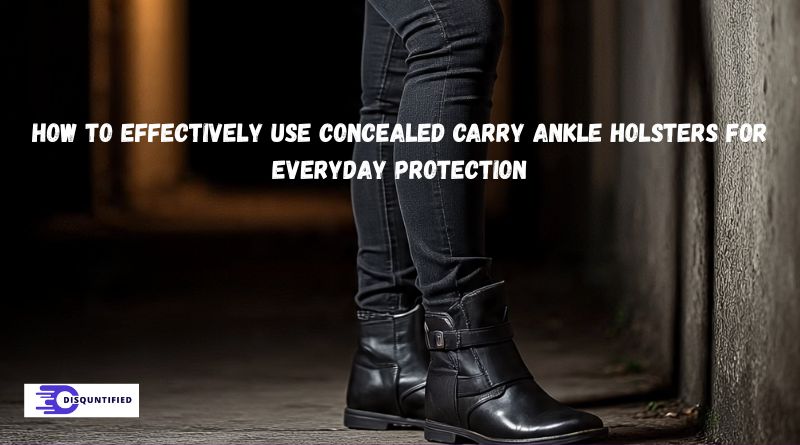Understanding Ankle Holsters
Concealed carry ankle holsters offer gun owners a unique and discreet way to carry their firearm. Securing the gun around the lower leg, this method of carry is especially useful when other options, such as waistbands or shoulder holsters, are inconvenient or visible. Whether you spend long hours seated, work in professional attire, or simply value low-profile security, concealed carry ankle holsters can make carrying your weapon both safe and nearly undetectable.
The primary appeal of ankle holsters is their ability to keep your firearm hidden—even in situations where other methods may be visible or exposed. Individuals who drive frequently, work at a desk, or have specific clothing requirements often find ankle carry to be the best solution for everyday concealed carry needs.
Advantages of Ankle Carry
- Discreetness: These holsters facilitate a high degree of concealment. Under loose-fitting pants or with high-top shoes, the firearm remains both accessible and undetected.
- Accessibility While Seated: Ankle carry shines when quick access is required while sitting—making it advantageous for drivers or anyone working at a desk.
- Backup Weapon Option: Many individuals use ankle holsters for a secondary, backup firearm, ensuring readiness should the primary weapon be out of reach or malfunctioning.
For those exploring advanced tactics, a backup method like ankle carry is often an integral part of a personal protection plan. I
Choosing the Right Ankle Holster
Selecting the right ankle holster is essential for comfort and reliability. Start by considering the material, as breathable options like neoprene or leather enhance day-long comfort, while inexpensive synthetic materials may irritate after extended use. Always opt for models that are tailored to both your ankle and firearm, ensuring a secure fit without excessive movement. Pay special attention to retention systems such as thumb breaks or reinforced straps to ensure the firearm remains in place even when running or engaging in strenuous activity. According to Outdoor Life, which offers a detailed guide on the best ankle holsters, top-performing models combine comfort, durability, and reliable firearm retention, making them suitable for both everyday carry and backup use.
- Material: Breathable, padded linings prevent skin irritation and slippage.
- Fit: Select a holster specifically designed for your firearm make and model, as well as your ankle width.
- Retention: Prioritize holsters with proven retention mechanisms to prevent loss or accidental drop.
Proper Placement and Drawing Techniques
Maximizing both safety and speed requires proper holster placement and regular practice. For right-handed users, wear your ankle holster inside the left ankle; for left-handed individuals, wear it inside the right ankle. This allows for a natural, cross-body draw and shortens the time required to bring your weapon on target.
Mastering the Draw
- Secure your non-dominant hand to pull up your pants leg quickly.
- Step back with your dominant foot, bending the knee for stability and easy access.
- Always keep your head on a swivel—situational awareness is key.
- Use your dominant hand to quickly draw the firearm, ensuring your off hand avoids the muzzle.
Regular dry-fire practice and repetition of these steps will significantly enhance your draw speed and increase your confidence in high-pressure situations.
Clothing Considerations
Wearing the proper clothing is crucial for keeping an ankle holster concealed and easily accessible. Select pants that are loose-fitting or have a boot-cut style; these prevent the shape of your firearm from printing through the material and provide ample space for a smooth draw. High-top footwear, such as boots or athletic shoes, can further aid concealment and keep your holster securely in place, preventing it from sliding down your ankle.
- Pants: Boot-cut jeans or loose-fit slacks work best.
- Footwear: Durable high-tops or boots will improve comfort and weapon stability.
Keep in mind seasonal changes in clothing—consider how different fabrics and fits may impact both concealment and accessibility.
Safety and Maintenance
Ensuring your ankle holster remains safe over time requires regular inspection and upkeep. Carefully check your holster for any signs of excessive wear, weak stitching, or failing fasteners. Test retention features after each use and consistently clean your holster according to the manufacturer’s guidelines. Regular draw and reholstering practice is crucial, not only for safety but also for reinforcing the muscle memory necessary for an efficient response during real-world encounters.
Legal Considerations
Before carrying a concealed weapon, it is essential to understand your local and state laws regarding concealed carry. Laws change frequently and can vary between municipalities, so it’s essential to stay informed about training requirements, permit renewals, and restricted areas. Being up-to-date on legal guidelines is a fundamental component of responsible firearm ownership and personal protection.
Conclusion
Using ankle holsters for concealed carry can offer unmatched discretion, comfort, and preparedness for a broad range of everyday scenarios. By carefully selecting the right holster, investing time in practicing safe and efficient draw techniques, and adhering to legal standards, you can significantly enhance your everyday security strategy.

